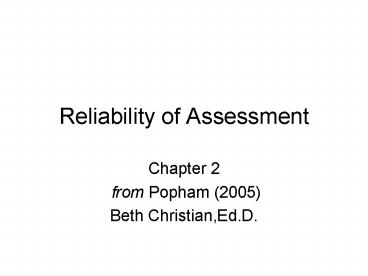Reliability of Assessment - PowerPoint PPT Presentation
1 / 13
Title:
Reliability of Assessment
Description:
Why do we need to know about reliability, validity, and absence of bias? ... Polytomous= multiples responses/scores. Classification Consistency ... – PowerPoint PPT presentation
Number of Views:476
Avg rating:3.0/5.0
Title: Reliability of Assessment
1
Reliability of Assessment
- Chapter 2
- from Popham (2005)
- Beth Christian,Ed.D.
2
Why do we need to know about reliability,
validity, and absence of bias?In other words,
why cant we just get straight into the practical
stuff making tests, rubrics, etc?
3
Quality Assessments
- In order to make the quality assessments
discussed in the next 7 chapters, we need to
understand how to determine that our tests are of
good quality.that is, that they are - RELIABLE Consistent
- VALID Accurate
- ABSENT of BIAS Fair
4
Reliability
- The extent to which tests are consistent
- In other words, it should not matter whether the
student takes the test in the morning, afternoon,
or one day or another, scores should be consistent
5
Three Reliability Measures
- Stability or Test-Retest-(same test twice at
different timescorrelation between scores and
time 1 and time 2) - Alternate Form- (two forms of same
test)correlation between scores of Test 1 and
Test 2) - Internal Consistency-comparison of items on a
testcompare one half of the test to the other
half or use (Kuder-Richardson Formula 20 or
Cronbachs Alpha).
6
Stability Reliability
- Consistent test results over time
- Similar results on different occasions
- No significant events that might alter
performance on second occasion between testing
occasions - Correlation coefficient reflects the degree of
similarity between two tests
7
Correlation Coefficient r
- Reliabilty coefficients range from 0 to 1.0.
- r0no reliability
- r1perfect reliability
- Ex. r Above .80 usually good
- Ex. r Below .50 usually poor
8
Alternate Form
- The consistency of challenge inherent in two of
more supposedly equivalent forms of the same
examination - Two tests given to same individuals with little
or no delay b/w testing occasions - Results given as correlation coefficient
9
Internal Consistency Reliability
- The extent to which the items in an educational
assessment instrument are functioning a
consistent fashion - Can be computed based in single test
administration - Ex. If a student answers an item on a test
correctly, he or she will answer a similar item
correctly
10
Formulae for computing internal consistency
(Terminology)
- Kuder-Richardson (K-R Formula)used for
right/wrong answers such as multiple choice - Cronbach Coefficient Alpha- for items in which
students are given points such as essay questions - Dichotomous itemsright/wrong
- Polytomous multiples responses/scores
11
Classification Consistency
- Classification consistency reliability is, as the
label suggests, a representation of the
proportion of students who are classified
identically on two different test forms or two
different administrations of the same test.
12
Standard Error of Measurement
- The consistency of particular persons
performance - The consistency of a persons performance if an
assessment procedure was administered again,
again, and again - The higher the reliability, the smaller the
standard error of measurement will be - Reminds teachers about the imprecision of the
test scores that an individual receives-the
scores on commercial of classroom tests are not
all that exact
13
What do classroom teachers really need to know
about reliability?
- Popham (2005) says not all that much.
- Teachers do not need to compute reliability
coefficients for the own classroom tests. - Teachers do need to understand the imprecision of
educational measurement





![[PDF] Orthopedic Physical Assessment (Orthopedic Physical Assessment (Magee)) 6th Edition Full PowerPoint PPT Presentation](https://s3.amazonaws.com/images.powershow.com/10084240.th0.jpg?_=20240723111)

























